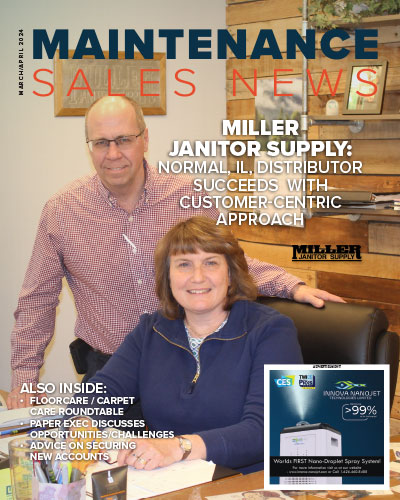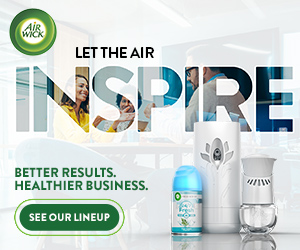Paper Executives Share Their Insights: Opportunities, Changes And Challenges To Continue Within AfH Towel, Tissue & Wiper Marketplace
Such essential items as paper towels, bath tissue, non-woven wipers and napkins are a requirement for just about every type of away-from-home (AfH) facility. As a result, opportunities, changes and challenges are expected to continue for those companies involved in manufacturing, distributing and providing to building occupants paper-related products within the AfH landscape.
Paper company executives who were recently interviewed by Maintenance Sales News Magazine discussed trends within the industry, and how manufacturers, distributors and end-users can better work together to meet the growing needs associated with this important segment.
ESSITY
The outlook for the North American professional hygiene business, which includes paper and tissue products and systems, is strong for 2023, according to Essity’s Michael Berkowitz, Director of Customer Marketing & Commercial Excellence, Professional Hygiene, North America.
“For example, airplane travel — and therefore airport traffic — is edging closer to pre-pandemic levels. Restaurants are rebounding, filling tables and increasing take-out and delivery orders. As end-users return to their pre-pandemic behaviors, facilities need to be equipped with the right hygiene products that meet the evolving end-customer needs and end-user expectations,” Berkowitz said. “Today, with crowds of people returning to public spaces, the demand for professional-grade paper products and tissue is rising, and the industry is working to prepare for a continued sustained growth in demand. As such, we encourage distributors and manufacturers to work together, prepare for the increase in demand, and ensure adequate supply is available to meet end-customer needs.
“One area that still offers some uncertainty is the return to the office. While more employers are enforcing return-to-work mandates, it is often on a hybrid basis, creating unpredictability around which days will be busiest.”
He explained this creates challenges for cleaning contractors and maintenance companies to predict cleaning and hygiene product inventory needs. Therefore, adoption of technology will be critical this year, helping to provide cleaning contractors and facility maintenance companies the visibility and insights needed to adapt their cleaning and restocking rounds to secure the correct level of service.
As the industry experienced shipping delays, inventory shortages, and steep freight costs from 2020 to 2022, Berkowitz said it’s important paper/tissue suppliers and their distributor partners continue to work closely to evolve processes and systems, and adapt to a more volatile market. He added janitorial and sanitization segments are facing a challenging period. Financial pressure is high, with low building occupancy levels and increasing costs. Amidst today’s economic volatility, these industries are also experiencing a shortage of high-quality labor, which can be detrimental to the end-user experience. When a facility isn’t up to end-users’ standards, the facility’s reputation is at risk.
“Building service contractors (BSCs), for example, have fewer workers to conduct cleaning tasks. On one hand, BSCs could increase wages to engage their workers and incentivize them to stay, but increased pay does not address key challenges that cleaners still face, such as replenishing supplies, managing inventory and conducting dispenser checks, all while understaffed,” Berkowitz said. “Technology is solving these pain points. For example, data-driven cleaning solutions can help to alleviate labor shortages.”
That includes the use of sensors in dispensers to gather real-time usage data. Via easy-to-use dashboards and notifications, cleaning staff is informed when and where there are refilling needs in a specific location within a facility. Data-driven cleaning technology also helps monitor visitor traffic to make staffing more efficient and optimize cleaning frequency and level. The technology also promotes best practices that minimize risks associated with infectious agents like COVID-19.
“One trend we’re continuing to see is a heightened public concern for hygienic and clean facilities. The pandemic has left the general public hyperaware of their surroundings, and consumers expect facilities to maintain high cleaning and hygiene standards to reduce the spread of germs,” Berkowitz said. “According to a 2021 survey commissioned by Essity, 73% of public restroom attendees use paper hand towels to avoid touching different surfaces in public restrooms. And what many end-customers don’t recognize is that nearly 7 in 10 users prefer paper hand towels instead of air dryers. These end-user trends are an important piece of information for distributors.
“Lastly, we’re seeing shifts in end-customer sustainability priorities. During the pandemic, sustainability was deprioritized as many companies faced a challenging economic time. Now companies — especially Fortune 500s — are reprioritizing their sustainability commitments, and are looking for a professional hygiene supplier that understands their current and future expectations to meet sustainability targets.”
Products that can help include foam soap and heavy-duty cleaning cloths that utilize biobased ingredients and materials to not only meet end-customers’ sustainability needs, but also exceed their hygiene and efficiency expectations.
“While selecting a hygiene solution, distributors must also seek a manufacturer that offers a broad assortment of sustainable systems,” he said. “Distributors should prioritize organizations as well that provide the right expertise and knowledge to address the specific needs of a given end-customer, and can help guide them as they move toward their own sustainability targets.
“It’s important to recognize that every end-customer has unique hygiene needs and sustainability goals. As a result, it’s imperative that distributors approach each one with a tailored offering.”
When asked what distributors can further do to increase their presence within the paper/tissue marketplace, Berkowitz explained the end-customer buying journey has evolved immensely over the past several years. In fact, 57% of end-customers are making decisions before they even talk to a sales representative, according to a Demandbase survey. If distributors want to increase their presence within the professional hygiene marketplace, the most important thing they can do is take on an omni-channel approach when developing their commercial plans.
He added omni-channel includes both online and offline touchpoints that impact buying behaviors. That means leveraging the appropriate touchpoints, such as websites, social media, physical events and sales representatives — to name a few — to deliver a superior end-customer buying journey that engages with them in their preferred touchpoint.
“In addition, B2B decision makers are using more channels than ever before to interact with suppliers, according to McKinsey & Company,” Berkowitz said. “It’s therefore critical that distributors are available in as many touchpoints as possible, and more importantly, are selecting a partner that provides them with the right tools to activate, using turn-key materials, to deliver the best customer experience.”
In summary, as distributors plan for the remainder 2023 and beyond, Berkowitz said it’s critical to select the right partner that will deliver sustainable and bundled hygiene solutions, coupled with a consultative approach, award-winning products and services, and industry-leading expertise.
Essity is a leading global hygiene and health company that is dedicated to improving well-being through its products and services. Tork is a global brand of Essity, and provides industry-leading solutions such as the award-winning Tork PeakServe® Continuous™ Hand Towel System. Tork products include dispensers, paper towels, bath tissue, napkins, soap, hand sanitizers, industrial and kitchen wipers, and software solutions for data-driven cleaning. Tork has developed full-bundled offerings, such as the Tork Campus Hygiene Package™ and Tork Office Hygiene Package™ , that, when paired with the expertise of Tork Hygiene Advisors, provide customized hygiene programs for end-customers. In addition, Tork now offers an even wider range of wet and dry wipes to address surface hygiene needs with the recent Essity acquisition of Legacy Converting. Visit torkusa.com.
BERK INTERNATIONAL
Solid communication practices and strong partnerships between manufacturers, distributors and end-users are essential when meeting the various needs of the AfH non-woven wiper, paper and tissue market segments, according to Berk International President Jake Berk. The company is a longtime converter of disposable wiping products which includes non-woven wipers.
He explained it’s important that continual dialog takes place involving all parties.
“For our industry, that should include discussing which type of wipers, and other paper/tissue products, work best for certain applications and markets,” Berk said. “It’s important to start, and continue, such conversations. It’s easy to get comfortable with your current business, but it’s important to reach out and find other options that can benefit your customers in the long run, to better meet their growing needs. That is certainly true with non-woven wipers.
“For example, it’s good to ensure the type of product being sold to customers is working well and used appropriately. I also feel it’s good when distributors help their end-customers keep an eye on order patterns. Not only does that help distributors make sure they are not losing business, but can boost efforts in customer service.”
In a product category like non-woven wipers, where there are many variations, both the manufacturer and the distributor can help find solutions to different problems being experienced in the field, Berk added. Staying on top of such variations, and making sure the customer knows he/she has options, is beneficial.
New product development is also important. Berk explained there is always new products being introduced in the non-woven wiper space. That includes presenting a type of material in a different format to “keep things fresh.” He added manufacturers and distributors can leverage today’s advancements in technology to provide new product options for the wiper, paper and tissue segments.
Berk also reported that it appears more purchasing decisions are being made today based on the value of a product and its best use for a specific application, rather than just the price of the item.
“Back in the day, it seemed more people were interested in simply finding the cheapest case of product. Today, there is more interest in the best application for a particular item, how many sheets are available, what is the size of those sheets, etc. There is more of a focus on real value,” he said.
When it comes to non-woven wipes, Berk added there remains a need, among many end-users, for strength and absorbency.
“That need is across the board, and provides a lot of product growth. There also remains a strong desire for general-purpose wipes. Any cleaning application can use a general-purpose wipe,” Berk said. “That type of wipe may not be as strong as a heavy-duty item, but if it’s super absorbent, it’s a great product to provide many end-users.”
Distributors can also help their customers who are looking to meet certain sustainability/environmental goals. Berk said most non-woven wipers, as well as paper/tissue products, have options available in order the better protect the environment. That includes products with recycled content and/or are compostable.
“Distributors should ask their manufacturer partners about products that are considered environmentally friendly. A manufacturer may not market an environmentally friendly product in every category, but may have access to another item that will work,” he said. “There are usually options available for most categories.”
Berk added he remains bullish, for 2023, regarding the overall AfH non-woven wiper, paper and tissue market segments. It helps, he said, when manufacturers and distributors have available an extensive product line and are price competitive.
The overall availability of AfH non-woven wipers, tissue and paper also seems to be strong, according to Berk.
“Supply levels have been good, and nothing like the height of the COVID pandemic, when supply was an issue,” he said. “I believe it’s important for distributors to work with manufacturing partners that provide an extensive line of products with a lot of options. That allows distributors to go after the greatest amount of business. Distributors should also be able to pivot to another product, if an item being offered to an end-user is not working well. It’s always important to get the right products into the hands of end-users.
“It’s beneficial as well to partner with a manufacturer that offers sales training options. With non-woven wipers, that includes sharing information on the differences and benefits of air laid, DRC and hydro spun products.”
Berk International is a leading manufacturer and marketer of towel, tissue and non-woven disposable wiping cloths. The privately-held company, based in Boyertown, PA, offers a full range of standard, custom and specialty wipes for use in the jan/san, industrial, health care, food service, automotive, electronics and aerospace markets. Visit berkwiper.com.
SOFIDEL GROUP
Although there remains a strong belief that 2023 will be a significant year for the AfH market in North America — as recovery from COVID-19 continues and businesses re-establish their “new norm” — there is still a gap in place from the historical norms of 2019, according to Sofidel America Executive Vice President, Marketing & Sales USA Derek Dafoe.
“The current concern about economic pressures the economy is facing, and the labor challenges that are holding back accelerated growth, are balanced by ongoing industry consolidation and, the continued shift to digital commerce,” Dafoe said. “Overall, we believe AfH will become a strong growth engine for the economy, business, and trend-setting realization in 2023.”
He added 2022 was a year of challenges, which included a decrease in AfH tissue availability within the North American marketplace, driven by significant inflation and ongoing supply chain disruptions.
“The importation of both consumer products and jumbo reels was driven to historically low levels, while the cost of domestic products accelerated like nothing seen in the recent past. In short, demand exceeded supply,” Dafoe said. “For 2023, we anticipate a stabilization involving the cost pressures the industry faced, and a more balanced level of supply and demand, albeit imports will gradually re-enter the North American market.
“We believe the level of imported goods will normalize by the end of the year, allowing for a better balance in some historically import-dependent subcategories, and providing more jumbo reel paper for converters to source.”
He noted today’s jan/san market is facing a significant reinvention. There have been areas of the market that have shown strong signs of recovery from the pandemic, while other areas must better adapt.
“For example, major metropolitan areas are struggling to bring workers back to the office, thus shifting demand and causing a re-evaluation of how to go to market in that segment,” Dafoe said.
Overall, he added, there are two trends that are dominating the industry, heading into 2023:
- Consolidation: Over the last three years, many independent jan/san distributors have been acquired and consolidated to create larger “national” entities.
“There will be continued consolidation within the industry in 2023, which will lead to the beginning of a national strategy for many of the ‘acquiring’ corporations, as they seek to create national value. True, the industry has experienced this type of consolidation in the past, but we feel these new entities will quickly establish themselves as industry leaders, with a drive to dramatically shift how traditional jan/san distribution works,” Dafoe said. “Interestingly, this is similar to the trend experienced in food service distribution over the last 25 years. There will always be independent distributors, but the rise of true national leaders is something we believe will be foundational in 2023.”
- Digital Commerce: Amazon continues to make inroads in the jan/san segment. The company’s test-and-learn efforts, and considerable resources, are providing Amazon with an opportunity to transform traditional jan/san distribution, according to Dafoe.
“As this becomes more of an opportunity/threat, we believe that the truly strategic jan/san distributors will place more emphasis on creating true digital — and even direct-to-business — strategies, positioning the industry for significant change,” he said. “Digital commerce will continue to grow and represent a strategic advantage for those who lead in this area.”
Despite challenges, Dafoe said there is room for distributors to increase their presence within the paper/tissue marketplace. He added the paper/tissue category is a mature business that creates consistent demand and throughput. There are two main drivers for the category:
- Cost/Comfort: “Unfortunately, the traditional customer has prioritized cost over comfort, much to the distress of their own customer base,” Dafoe said. “Moving forward, we feel progressive distributors will find ways to balance cost/comfort that will provide greater value to their customer base, offering a mix of assortment and rethinking about the category in end-user terms, improving the category.”
- Value-Added: “Additionally, the days of commodity paper are in the past. Truly progressive manufacturers and distributors are finding ways to offer value-added offerings that are tailored to solve end-user problems, such as increased flush ability, rapid dissolving tissue/towels, and towels that offer germ control,” Dafoe said. “Opportunities are available. Truly driven distributors can take the lead by offering value-added solutions.”
Moving forward, he added, the end-user demand cycle will continue to push for greater product comfort and sustainability.
“End-users want a product that provides performance, comfort, and sustainability — and at a fair price. By working with industry leaders and independent third-party certification organizations, there is a move away from basic recycled to more performance-driven, FSC-certified options,” Dafoe said. “We believe end-users will continue to demand more of their tissue experience, even in B2B settings.”
The same is true, Dafoe added, when it comes to customer service.
“Traditionally, developing the end-user relationship was challenging when it came to distributor/supplier engagement. In the future, we believe that true supplier partners will offer more value to both distributors and their end-user customers. By engaging with a supplier’s customer service and quality teams, the end-user experience is elevated, and concerns are dealt with factually and pro-actively — versus in a general non-descriptive manner,” Dafoe said. “While today’s end-user business tends to be dominated by branded manufacturers who force distribution, we believe that a true opportunity exists when partnering with suppliers and distributors that offer a value-added service for the end-user.”
That involves understanding concerns, working together on demand patterns, forecasting, and quality issues.
“Partnering together, on both supply chain and end-user experiences, can play a key role in customer service,” he said.
Another area of promise involves how advanced technology can meet the growing needs within the paper/tissue segment. Dafoe said distributors should have a role in the process.
“In today’s world, often when we mention technology, we transition into talking about e-commerce and digital commerce. Although there are significant developments in those areas, we believe there is equal opportunity in operational and supply chain technological advances that can improve the end-user experience,” he said. “Modern paper machines, for example, combined with new converting equipment, allow for softer, smoother, and more absorbent products, not to mention significant improvements in sustainability. The average age of a paper machine in North America is over 25 years. Many get remodeled or rebuilt, but in layman’s terms, would we ask for an airplane from 25 years ago to offer the same performance as an airplane of today?
“Keeping up with technology and optimizing performance require incremental investment, one that provides higher performance, improved cost efficiency, and increased environmental focus — all key value-adders for today’s end-users.”
He explained that distributors who partner with suppliers willing to invest and reinvest in their businesses can position themselves as industry leaders, shifting the distributor/supplier relationship from one of a mere transaction to one of strategic engagement. As a result, improving the tissue experience for end-users leads to longer-lasting “sticky” business, in a category that has high usage and drives engagement.
“Often, end-users don’t think about their tissue needs until there is a problem. Partnering with leading suppliers, however, allows distributors to better bring various tissue considerations front and center,” Dafoe said.
Helping end-users meet their environmentally friendly/sustainable goals is also important for a distributorship. According to Dafoe, today’s end-user is more focused on truly understanding environmental positions that involve products, services, and businesses.
“In the tissue world, there has been a high level of green washing over the years, creating frustration and confusion for all involved. Early efforts at ‘sustainable’ tissue resulted in rough, or poor performance. Many end-users became accustomed to sacrificing performance for sustainability. In today’s world, however, that is no longer true, but there continues to be noise, involving recycling, bamboo, wheat straw, certifications that can be complicated, and talk of harvesting versus supply chain versus processing, etc. Truly, it is a maze of complications for the end-user to understand, when it comes to what is, and what is not, ‘green,’” Dafoe said. “Through partnering with reputable suppliers, today’s distributors can provide end-users guidance to clear up the fog, and lay out a fact-based approach to full sustainability when it comes to tissue paper.
“In short, using third-party certified, fact-based measures and clear, unbiased communication can create a ‘green’ way of providing end-users with both performance and sustainability — one that benefits the long-term health of the planet.”
With over 50 years of history (established in 1966), the Sofidel Group is the 6th largest manufacturer of tissue paper in the world (the 2nd in Europe). Sofidel offers a wide range of tissue and towel products and dispensing systems. Visit sofidel.com.
NPS HOLDINGS LLC
Optimistic about the possibilities that 2023 can bring to the North American AfH paper and tissue marketplace is NPS Holdings LLC President/CEO Jim Brown. He added, however, that overall growth in the market will likely still follow the percentage of population growth, which is typical.
“The market, other than in 2020 which was influenced by the COVID pandemic, has typically been on a growth path of 2 to 3 percent, which is basically the normal rate of population growth. AfH tends to follow the rate of population expansion, and obviously inflation also plays a factor. Inflation has driven up certain costs, and higher prices have been the result,” Brown said. “From a (paper) manufacturer perspective, I can certainly say there was a lot of turmoil in the market last year (2022). Some manufacturers struggled, which provided opportunities for others to take share of wallet (SOW). I do think 2023 looks much better, especially for the smaller converters, who I feel can increase their market share. There is also certainly a lot of consolidation taking place in the industry, involving both distribution and manufacturing.”
Brown added that the availability of paper/tissue for the North American AfH marketplace has improved from major challenges that gained international attention over the past few years — mainly supply chain disruptions and higher freight costs.
“There was not enough capacity available in the United States for converters, brought about, in part, by high freight costs per container from China. It created a situation where U.S. converters that relied on paper from China had to buy it elsewhere, and eventually ran out of paper. Our industry went about four months on allocation, at around 60 percent of what is considered normal supply,” he explained. “That went on from April through July 2021.
“As freight prices have come down, we are now seeing increased imports from China. That is improving the supply situation. There are still some substrates, however, that are difficult to get.”
Brown also discussed the importance of distributors continuing to look at ways to meet the different needs of their AfH end-user customers within the paper/tissue segment. For some distributors, diversification is key. He noted that many of the larger, often recently-consolidated jan/san distribution houses are diversifying into other markets, such as food service and government office space. This focus, however, can leave more room for other distributors to operate, within the specific jan/san segment.
He added price is a big issue right now for many distributors, as well as their end-use customers, when it comes to paper/tissue supplies. A lot of pricing concerns started last year with the lack of paper. Demand for paper went up, and therefore, so did prices. Although paper/tissue supply has improved, inflation is driving up manufacturing costs, keeping pricing at parity.
One way to combat that is through customer service. Just as distributors rely on their paper/tissue suppliers to provide them with 100 percent quality and lead time capabilities, the same is true for end-users who work with those same distributors.
“Even with higher pricing, it’s possible to win business with customers through superior products and services. There are companies that will undercut pricing, but they may not serve their customers as well,” Brown said. “If a paper manufacturer, for example, is staying ahead of schedule with supply, a trickle-down effect can take place, with a distributorship receiving that paper on time to better service its own customers.”
Today’s technology can play a big factor as well for distributors when it comes to service, such as using forklifts equipped with Wi-Fi technology for more efficient “picking and pulling” of products.
“Why is Amazon so successful? Because it sends the right product out every time, and it arrives on time,” Brown said. “Today’s technology can better show where product is in the warehouse, and how to best get it quickly to the customer. A lot of distributors today are using such technology to improve their warehouses. This must happen, as many people running distribution companies are finding themselves competing directly with Amazon. Technology improves accuracy and speed to market.”
A focus on sustainable practices, “green” products and third-party certifications is also key.
“I feel it’s important to work with a paper manufacturer that has a solid record on sustainability, such as using recycled products and protecting wastewater. It’s also important to look for proper green certification,” Brown said. “Unfortunately, due to supply and demand issues in the recent past, there has been a tendency by some to shy away from such products and practices within the industry. The good news is, I see the focus for greater sustainability coming back in importance.”
NPS Holdings LLC is an “Innovative Tissue & Specialty Products Leader.” The American company has both a corporate-based headquarters and established manufacturing locations supporting local communities. Products include AfH tissue, towels, napkins and proprietary dispensing systems. Also included are environmentally friendly insulated and protective packaging solutions; with segments including retail, home delivery, and packaging distributors. Additional commercial and consumer-based disposable solutions, including wipers and hygiene products, are also available. Visit npsholdings.com.











